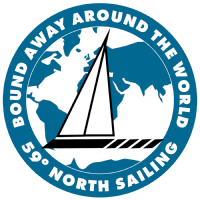
What to Expect Offshore
Life at sea
Offshore sailing is as close as we ‘normal folk’ can get to being astronauts. Crossing oceans requires self-sufficiency, traveling across wide, hostile (yet beautiful) expanses at a ‘human’ pace, where the hours and minutes go by slowly but the days go by in a flash. Offshore we’re intimately connected with nature yet disconnected from our lives back home. All of us go to sea for different reasons, and everyone comes back changed, in one way or another. What follows is a practical list of things to expect on the boats at sea. What we can’t possibly communicate is the philosophical expectations — for that, you just have to do it to see for yourself.
why 59° North?
If you've made it to our site, you probably don't need an answer to the 'why?' question. It's a question without a real answer anyway. We go offshore because the ocean is there, we do it for the personal challenge and to fulfill a need for discovery.
Some people simply 'get it,' and no explanation of why you should venture offshore is needed. 'Won't I get bored?' some people ask. Those who 'get it,' know that answer is 'no.' There is no such thing as boredom on a long ocean voyage. The minutes and hours may drift by slowly, but the days go by in a flash.
We go to sea to learn about ocean sailing, but we come back having learned more about ourselves than any technical aspect of sailing a boat. The sailing part is easy. But do we have it in us to withstand the wind, seas and spray at the helm on a dark, cold night offshore? Do we have it in us to withstand the feeling of exposure one gets at sea, of being so small and vulnerable, the boat wrapped around you like a tortoise shell. Do you ask yourself these questions of yourself? Can we withstand the brutal seasickness that befalls everyone who goes to sea, sooner or later?
So, it's hard to put your finger on it, right? But if you've got the opportunity, whether with us or with someone else, GO! You won't regret it, and it might even change your life...
Philosophy aside, Mia & I, and the skippers & mates we hand-pick to work with, are very good at leading offshore sailing passages, and (we've been told), we're pretty fun to hang out with! Through some of the 'intangibles' that the 59º North Team possesses, we can offer an experience that is far greater than the sum of it's parts.
How much experience is required to sign on for a passage?
The short answer? NONE! We have had several crew who have never even set foot on a sailboat before, but they have the dream, and that’s what’s important. Our crew, John M., always dreamed of seeing the ‘stars down to the horizon,’ yet he’d never been sailing. He changed that with us, and has since been as far as South Africa to complete a coastal nav. course and sails regularly on Lake Ontario in his free time. You’ll of course understand more of what’s going on the more experience you have, but it’s not in fact required.
That said, we DO require a certain level of physical fitness to join us offshore. Regardless of how much we emphasize it, most people still underestimate how difficult it is simply to LIVE on the boat offshore, even on a nice day.
What can I expect to learn on a 59º North trip? Do I get a certificate?
59º North is not a sailing school, and we don’t issue any official certificates (but will gladly sign your logbook), but crew often say they have learned more in one day with us than a full week of formal class. That’s because we teach the real thing, with real stakes, having to get the boat from one port to another in varied weather and on a timeline.
Focusing on fundamental seamanship, we’ll teach you how to anticipate the weather & make routing decisions, how to optimize the sail plan for different points of sail in different conditions, how to helm, how to use the radar and on and on. You will become a better sailor — and a better thinker — sailing with 59º North.
We’ve created an environment onboard that fosters hands-on learning and teamwork. Our skippers and mates are almost always co-ed, and we sail with a diverse crew of mixed genders, nationalities, ages, sailing & life experiences. Everyone gets an equal opportunity to participate in running all aspects of the boat, from navigation, helming, sail trim etc., and yet nothing onboard happens by accident. Skippers & mates manage the crew’s varied fitness and skill levels to make sure everyone stays safe while being able to fully participate.
What amenities are there aboard ISBJØRN & FALKEN?
Not too many! Both boats offer a very simple but cozy & comfortable offshore sailing platform. Both boats have hot water, but the only showers in the cockpit, so it's bikini and board shorts for showering time (unless you’re really adventurous). Beds are proper sea bunks, and we provide sheets, 'Turkish cotton towels' and pillows. You'll need a sleeping bag on colder trips. ISBJØRN and FALKEN have heat, making colder passages a lot more enjoyable.
What’s included in the crew fee?
The crew fee for the passage includes everything you need on the boat, plus use of the following:
- Helly Hansen 'Inflatable' PFD with integrated harness to use while aboard.
- Spinlock Double-tether for moving around on deck to use while aboard.
- All meals, snacks and drinks while on the boat.
- Sheets, quick-dry towel & a pillow.
- Large collection of books onboard, including novels, sailing classics and sailing reference books, in hard copy.
What the price DOESN'T include:
- Transportation to and from the boat.
- Meals and drinks ashore.
- Personal toiletries & clothing.
- Foul-weather gear (see packing list for details).
What type of person makes for good crew offshore?
Quite simply, the folks who get along with others in confined spaces will do best onboard. There is no privacy on the boat except for in the head (and trust me, you don’t want to be there long!). Sailing skills are far down the list of things we look for. More importantly, potential crew should be open-minded, willing to work as a team, content with limited resources, know their limits (and when to wake the captain) and happy living simply.
Crew also need to have a minimum level of fitness and a clean bill of health. If you’re active in your daily life and have a solid exercise routine, you’ll do great offshore. If you don’t, we should discuss the realities of ocean sailing, which are far more rigorous physically than any other kind. If you’re unsure about this, please don’t hesitate to email us on holdfast@59-north.com.
Teamwork

ISBJØRN & FALKEN are in no way typical “charter boats” — this is an ocean passage after all, not a luxury cruise — and the expeditions we run are closer in spirit to climbing a mountain than they are to a typical Caribbean charter. We expect crew, with guidance from us of course, to take care of themselves for the most part when it comes to eating, sleeping & living on the boat.
The key to a successful passage is teamwork. The hierarchy goes like this — take care of the boat first, then each other. You'll be surprised how the mood can be lifted onboard by the simple offer of making your watchmate a snack on a wet & squally day!
Our goal is for your weaknesses to become strengths and for everyone to grow as sailors, no matter what your experience level (ourselves included!). When the skipper or mate are asleep, our lives and the safety of the boat depends on you! For us to get decent rest, we must be 100% certain you will wake us up at the slightest question. Lights on the horizon you’re not completely certain of, when to reef, which line to pull, etc. Do not do anything unless you’re sure it’s the right thing to do. This doesn’t mean don’t do anything at all without asking — we don’t run that tight a ship — but we’ve got to keep safety first. Plus, we’d prefer not to break anyone or anything.
We strive to get everyone included in all aspects of running the boat, but safety is our #1 concern. Nothing happens onboard our boats by accident — we'll closely monitor all crew's ability, health & fitness level and assign tasks accordingly. Sometimes you'll be asked to go to the foredeck, sometimes you'll be ask to handle lines in the cockpit. Please respect our decisions, but speak out if you feel left out or in over your head! You will never be punished for questioning orders you feel are unsafe.
Are there any traits consistent among the crew who do the best on the boat?
Yes! Go to 59-north.com/testimonials to get an idea of who sails with us and to read some personal testimonials from our crew past and present. In short, the common traits among crew are a lack of ego, a willingness to learn, eagerness to be part of a team, patience & unbounded enthusiasm.
How do couples fit in with the crew?
We often have couples join us, who might have plans of their own to sail over the horizon together. Onboard, we usually give couples the choice of whether they want to stand watch together or separately. Some people like to be split up in the watch schedule, to get independent experience sailing the boat. If you will sail double-handed in the future, you won’t be on watch together then either, so might as well get used to it! Other times, couples want to stand watch together, depending on their goals.
What’s the best way to prepare myself for going offshore?
Everybody who’s not been offshore, even the experienced coastal or inshore sailors, underestimates how physical it is just living on the boat at sea.. Everybody. The boat is constantly in motion, even on the nice days. Things like brushing teeth, going to the bathroom, just putting on socks take time and physical effort. To make it more difficult, you’ll be sleep-deprived during most of it, especially before you fully adjust to the rhythm. Offshore sailing is closer to living like an astronaut than coastal sailing where you get to stop and anchor for the night! Bottom line, the fitter you are to begin with, the easier time you’ll have at sea. Eat right and exercise!
Comms
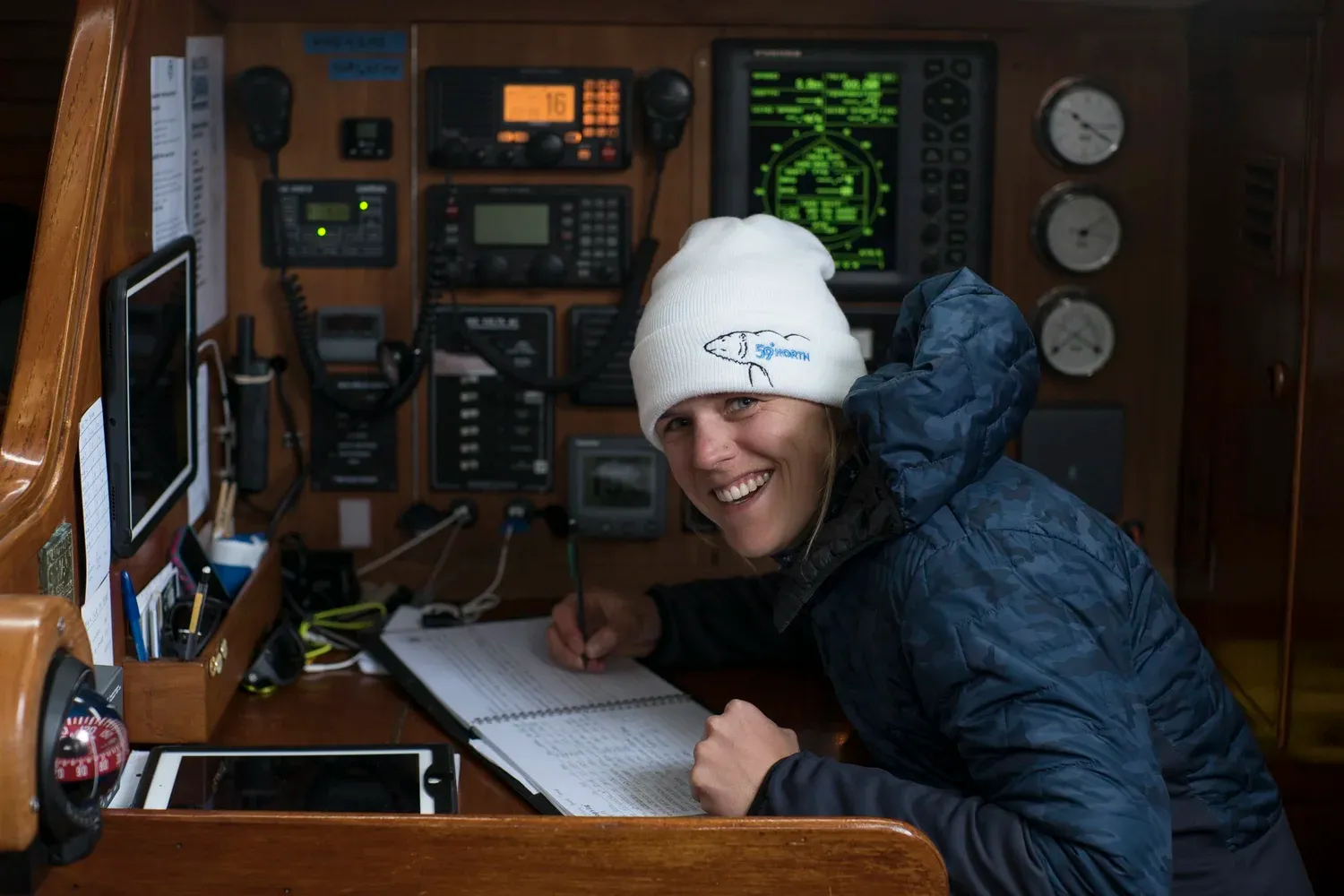
Being disconnected is increasingly rare in the modern world, and offshore sailing provides one of the last low-fi respites from constant ‘on’ technology. Yes, Starlink is a thing that more and more cruising boats are installing and using for seamless broadband during long passages. You won’t see it on a 59º North boat.
Crew should expect to be disconnected from the Internet while we’re at sea, and should see that as a feature, not a bug. You will return to civilization refreshed and slowed down in a way that’s utterly impossible. Ashore, disconnecting is a choice, and the temptation will always be there no matter how disciplined you are. Offshore, it’s the default mode. After a day or so of' ‘discomfort,’ you’ll quickly wonder why you ever needed it in the first place.
That said, we are not entirely shut-off from outside contact, and in fact the variety of sat comms onboard make up a big part of our safety culture. If crew want to stay in touch with family and friends during the passage, you are welcome to bring along your own simple Garmin InReach (or similar device).
Inevitably there remains the temptation to immediately fire up your phones as soon as the boat is close enough to landfall to get a signal. We urge you now, and staff will urge you on the boats to stay in the moment! Landfall is one of the most special parts of any offshore voyage, and while we fully understand the desire to share that with family and friends ashore, you’ll get much more from the experience if you stay present. Take pictures with your crewmates instead and plan to call your families once the boat is secured to the dock or at anchor (and only after that obligatory post-passage swim & bubbles toast!).
Will I be able to communicate with friends or family during the passage?
Not by default. We have emergency comms onboard and the ability for your family to contact the boat via Mission Control, but if you'd like to be able to connect directly to send/receive text messages, you'd need to bring along your own Garmin InReach or similar device. If you would need to make an emergency call home, we can arrange use of the ship's satellite phone.
Note that we do not, and will not, have Starlink for broadband Internet offshore (even if we do end up installing it, it will be for boat comms only and not shared with the crew). We believe that the limited connectivity during an ocean passage is a feature not a bug. This allows us and the crew to stay in the moment in a way that is impossible ashore, and the experience is that much richer for it.
A typical passage
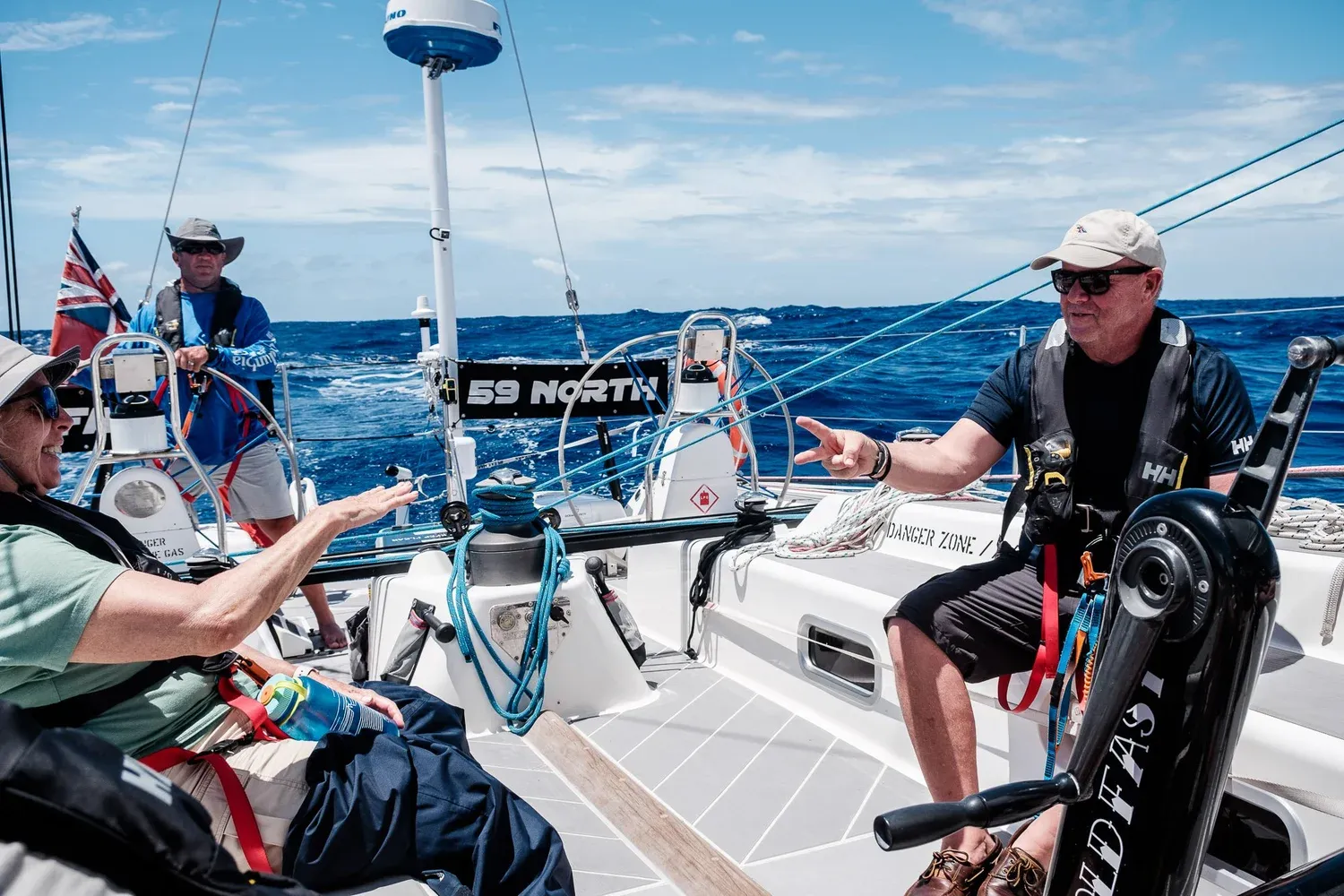
Celestial Nav: Do you have the tools and books so I can practice offshore?
Both boats are set up with all the books, tools, worksheets and sextants you need to do REAL celestial navigation offshore, and our skippers and mates are trained in the lost art.
On ISBJØRN we have a Tamaya sextant that Andy & Mia bought used at the famous Sailorman chandlery in Ft. Lauderdale for ARCTURUS back in the day and had onboard for their first trans-Atlantic in 2011. It's sailed everywhere that ISBJØRN has for over 70,000 miles, and Andy even has a tattoo of it on his left forearm!
FALKEN also carries a newer Tamaya sextant, given to us by Weems & Plath in Annapolis.
On most passages, we bring out the sextant for a quick celestial primer and if you are extra keen, you are welcome to use the sentant and run sights on your own.
How long are the watches?
Our watch schedule is flexible and ultimately up to the skipper. Traditionally, watches were divided into periods of 4 hours, with two different watches standing a 4-on / 4-off schedule, often with a small adjustment at dinnertime, and onboard ISBJØRN we normally follow this type of schedule. On FALKEN, we typically run a two-watch system, standing 6 hours on in the daytime, then 4 hours on at night. On tropical routes, when it’s hot in the daytime, we sometimes flip this to limit sun exposure. Regardless of which watch system we use, crew are always gathered together for dinnertime, allowing us to eat together and reflect on the day.
The skipper and mate stand a different watch schedule than the crew, so that one of them is always awake and supporting the crew. Their schedule allows them to spend time sailing with all the crew.
On an ocean race, where all crew is given specific roles, a ‘watch captain’ would ultimately be in charge of decisions on their watch. However, given the range of experience of the crew, we do not assign watch captains — rather, if there is discussion among the crew as to what to do, then the captain is woken up to settle the debate!
Can I join multiple passages, back-to-back?
Yes! In fact it’s not uncommon for crew to do just that—currently the record stands at 4 legs back-to-back-to-back-to-back! Benefits include getting to sail with different crew, and sometimes a different skipper/mate. You get time between passages to reflect on what you’ve learned on the first leg, and re-focus what you want to learn on the second.
A few things to note if you decide to join multiple legs:
- We ask crew to stay ashore during the break, to give the skipper/mate space & time to turn the boat around, and relax before the next passage. This give you an opportunity to explore ashore, or study up for the next leg. And grab a hot shower :)
- You’re welcome to borrow books from the boat library during the break, just bring them back!
- We do not offer discounts for multiple leg crew.
Down below
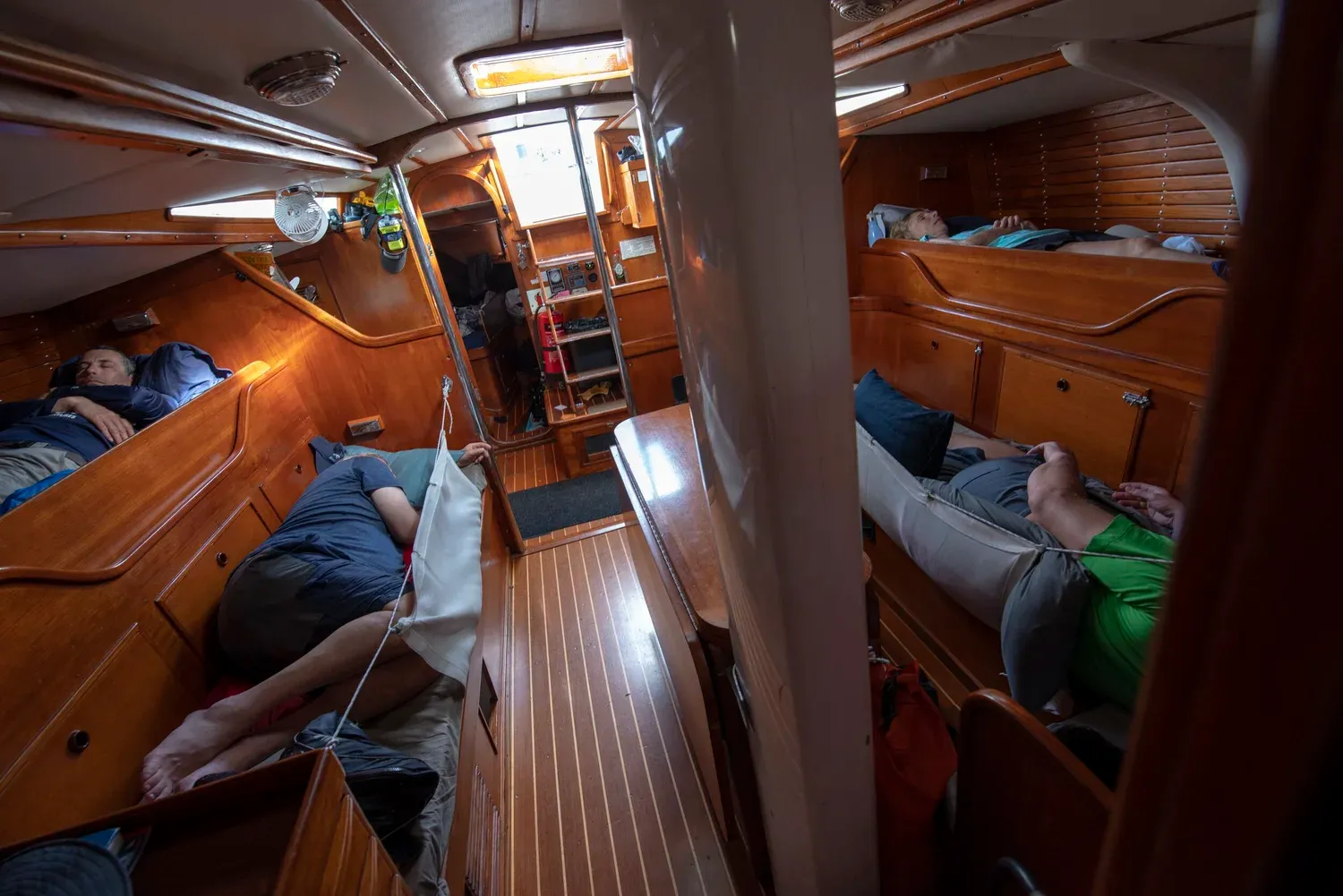
Each person will be assigned a single berth. This is yours. At sea, in certain extreme conditions, we may rotate where people sleep ('hot-bunking'), but your bunk remains yours for your stuff. No snacking or eating in your bunk under any circumstances!
- Each person will get their own locker for your personal gear and clothing, adjacent to your bunk (about 24x36 inches — think carry-on storage bin size on an airplane, but this space differs between the boats).
- On ISBJØRN and FALKEN you will be able to pack most of your belongings into your assigned locker. Most crew, however, find it easiest to work out of their bag directly and use the locker for jackets, shoes, shower kits, etc.
- There is shared space available for hanging your foulies and storing your boots outside of your locker.
How-to pack

Packing for an offshore passage can be tricky, especially when you are sailing through different temperature zones. In short, less is more. We don't think anyone has ever wished they'd brought MORE gear! Read on for some specific tips.
Once registered, you will receive specific packing list and instructions on how to pack. We have four packing lists — Cold Weather, Warm Weather, Transition Weather & Arctic Weather. Email us if you have specific questions before signing up.
What’s included in the crew fee?
The crew fee for the passage includes everything you need on the boat, plus use of the following:
- Helly Hansen 'Inflatable' PFD with integrated harness to use while aboard.
- Spinlock Double-tether for moving around on deck to use while aboard.
- All meals, snacks and drinks while on the boat.
- Sheets, quick-dry towel & a pillow.
- Large collection of books onboard, including novels, sailing classics and sailing reference books, in hard copy.
What the price DOESN'T include:
- Transportation to and from the boat.
- Meals and drinks ashore.
- Personal toiletries & clothing.
- Foul-weather gear (see packing list for details).
What clothes and gear should I bring?
Our passage-specific Packing Lists are sent out to all crew along with Newsletter #2 (about 4 months prior to the passage). You can see sample packing lists on each passage, tailored to the expected weather conditions - we include them as downloadable PDFs and they are free to use, even if you don't join the passage with us! If you have any questions, send us an email.
What’s the best way to prepare myself for going offshore?
Everybody who’s not been offshore, even the experienced coastal or inshore sailors, underestimates how physical it is just living on the boat at sea.. Everybody. The boat is constantly in motion, even on the nice days. Things like brushing teeth, going to the bathroom, just putting on socks take time and physical effort. To make it more difficult, you’ll be sleep-deprived during most of it, especially before you fully adjust to the rhythm. Offshore sailing is closer to living like an astronaut than coastal sailing where you get to stop and anchor for the night! Bottom line, the fitter you are to begin with, the easier time you’ll have at sea. Eat right and exercise!
Managing menstrual periods during an offshore passage.
As for having your period onboard, it is quite similar to having it at home except that we have fewer opportunities to shower. We have trash bins in the bathroom for easy disposal of hygiene products. We do not stock the boats with pads and tampons for everyone, you need to bring your own. We recommend disposable period products on our trips, as it is harder to wash reusable products onboard. We do recommend that all people bring baby wipes with them to help with hygiene, as we do not shower much on these trips.
Once registered, you will receive specific packing list and instructions on how to pack. We have four packing lists — Cold Weather, Warm Weather, Transition Weather & Arctic Weather. Email us if you have specific questions before signing up.
Any recommendations for seasickness?
Being jet-lagged and sleep deprived are triggers to getting seasick, we recommend crew to arrive a day or two before the passage starts to get the body adjusted. Staying off alcohol a few days before the trip doesn’t hurt, but we suggest you don’t change your diet before the passage, that can mess up your belly and systems. Using seasick medication onboard is optional, we require that crew test at least one seasick medication at home before joining the boat, and bring it along. Always consult with a doctor before trying new medication.
Where can I get further information on ocean sailing, in the style that 59º North promotes?
The best way is to join us on The QUARTERDECK!
How do we make travel plans given the uncertain nature of ocean sailing?
Our passages are scheduled based on the average speed of each boat. For example, we use 5.5 kts VMG (that’s ‘velocity made good.’) when planning ISBJØRN’s trips. This is a very conservative estimate for ISBJØRN, as we are usually averaging over 6.5 knots VMG (it's faster for FALKEN, as she's much bigger. In fact, on the About pages for each boat, you can see the historic passage states, including Miles per Day and VMG!) The conservative estimate ensures that we’ll get to our destination with time to spare before the last day of the trip. We still encourage crew not to book return air travel until we know for sure when we’re departing (some passages are easier to predict weather-wise than others, in the Trades in the Caribbean for example). Normally, if you book ahead, booking a ticket out on the final scheduled day of the passage will ensure you make your flight. Crew normally book a few days later and spend some time ashore before they depart.
How do you plan passage routes to ensure safe weather patterns?
Our passage calendars are created by Andy Schell & August Sandberg to specifically take advantage of seasonal weather patterns. We optimize our routes & sailing dates to ensure that we are sailing in the "right place at the right time." This means no summer passages to/from the Caribbean, for example, during the height of hurricane season, or doing an east-west trans-Atlantic in February, the best month for reliable Trade Winds.
We often commission "climatology studies" from our friends and partners at Weather Routing Inc. (WRI). The professional forecasters and weather routers at WRI analyze long-term trends for us, detailing the proposed routes at the proposed times of year. As we get more comfortable with the weather patterns in a given region, we're able to sail further into the shoulder seasons with confidence. When we venture to new parts of the world, we tend to plan more conservatively.
This planning takes place usually 2 years before passages will take place. When the time comes to set sail, we consult with WRI to find the optimal weather window for departure and always allow +/- 1-2 days leeway in the length of our trips (more for high-uncertainty routes, like the fall passage between the Chesapeake Bay and Caribbean, for example, when weather is quite volatile between summer hurricane season and winter gale season).
At-sea, we use a combination of automated GRIB forecasts and human-created updates from the forecasters at WRI to keep ahead of the weather and plan our routing strategy.
Weather
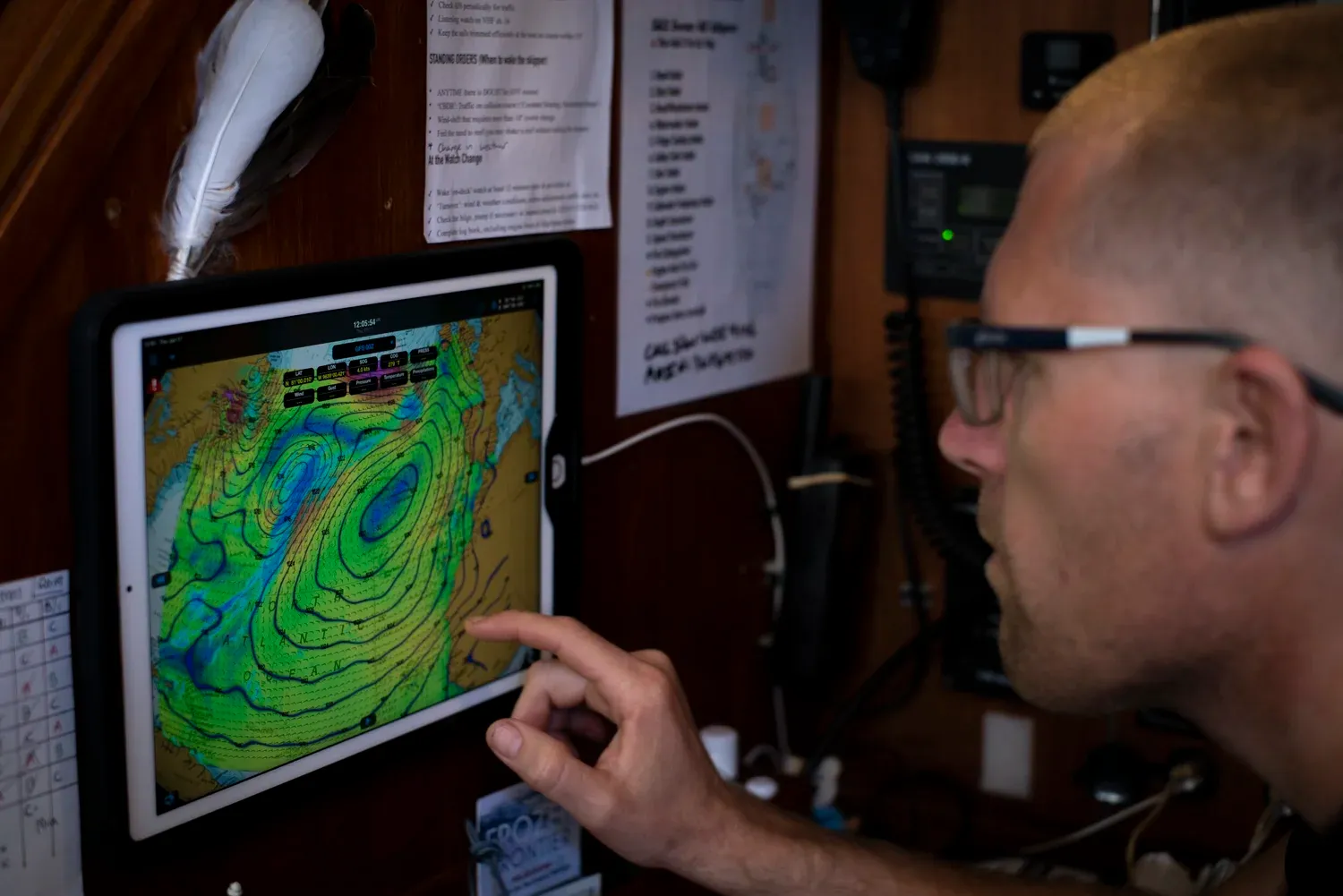
We choose our routes based on seasons (ie not sailing in hurricane season where there are hurricanes!), but once we head offshore, we get what we get. Sometimes it’ll be wet and uncomfortable and even downright scary!
You may encounter heavy weather, uncomfortable and possibly frightening conditions, seasickness, sleep deprivation and constant motion. This is all part of the emotional roller coaster that is ocean sailing. To illustrate how we handle forecasting and decision-making whilst at-sea, read this anecdote from Andy from FALKEN’s passage to Greenland in summer 2023:
“We had an interesting tactical situation unfold on the 800-mile leg from Newfoundland to Nanortalik, Greenland earlier this summer. The iceberg limit off southern Greenland was at about 59º north latitude. As we sailed north, the wind began to head us and increase. If we had continued sailing close-hauled, we’d have been set east of our rhumb line and would have arrived to the outer reaches of the ice limit just after sunset, in the dark and to leeward of our target. I clearly preferred getting through there in daylight and had been anticipating this scenario even during the planning week layover in St. John’s.
The question was whether we’d continue sailing that first night, then heave-to the second night to wait for daylight; or should we heave-to right away, ride out that first night while the wind was against us, and get underway again the next morning?
I debated this with myself in the log:
“The second option would give the wind a chance to back into the west again while we’re hove-to, so that come tomorrow morning we can get underway again on a reach instead of a beat, timing our arrival at the ice belt for dawn Saturday. Sounds pretty good right? On the other hand, the wind looks to get lighter overnight down here, so there’s a risk we heave-to and wind up having to motor through a calm in the morning to back into the breeze.”
We opted to heave-to that first night. It was the right call. The wind did back in our favor and by next morning we were full-sail again, close-reaching on our rhumb line, actually able to sail high of it. The GRIBs had showed a substantial increase in the wind as we approached the ice limit and I wanted to be positioned to windward of our landfall — picking our way through ice and fog and 25 knots of wind on a broad reach, sailing fast and flat and in control, would be vastly easier than beating into it.
The tactic worked.
I’m a huge proponent of prioritizing weather understanding over most other seamanship skills for ocean sailing. Being able to anticipate the coming 24-48-72 hours offshore allows you to set the boat and the crew up for short-term success, and this was a great example of that.
Beyond 3 days, forecasts get much harder to predict. I focus on certainty — if a model run of one GRIB forecast agrees with another over a 5-7 day timescale (for example the GFS & ECMWF), then I interpret a higher degree of forecast certainty. Another way to test this is one model run of the same forecast taken at different days. How much did the new one change from the old one? More change = less certainty.
Combine certainty with trends to dictate your tactics. An uncertain forecast that’s trending worse would give me cause for making conservative tactics. Conversely, a forecast with a higher degree of certainty and trending better would allow me to feel more confident making bolder tactical decisions.
The problem I’ve found is that most weather forecasters use the language of certainty rather than skepticism, even in longer-range forecasts. You’ll see phrases like “the wind will ease and shift to the E,” for example, rather than “is forecast to ease”. You get the picture.”
